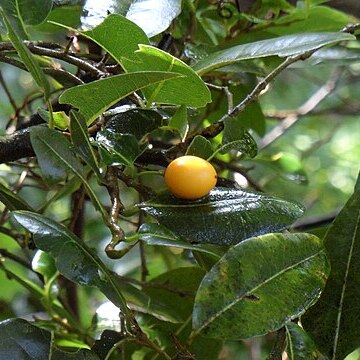Dioecious, polygamo-dioecious or more rarely monoecious trees or shrubs with a simple indumentum. Buds sometimes perulate. Leaves alternate, petiolate, stipulate, simple, entire or toothed, commonly asymmetrical at the base, often coriaceous, penninerved. Flowers fasciculate, axillary, or cauliflorous on the older branches or trunk, usually pedicellate. Male flowers: buds usually globose; sepals 4–5, imbricate, broad, concave, often unequal; petals 0; stamens 3–12(–50); filaments free, anthers erect, commonly introrse, thecae parallel, longitudinally dehiscent; disc central, flat, cupular, ± entire, lobed, laciniate or plicate, sometimes enfolding the filaments; pistillode 0 or minute. Female flowers: sepals as in ♂; disc hypogynous, annular, cupular or rarely 0; ovary 1–4-locular, with 2 ovules per locule; styles usually short or 0; stigmas thick, flattened, sometimes subpeltate, bifid, reniform or discoid. Fruit a globose, ovoid or ellipsoid drupe; pericarp somewhat fleshy, becoming indurated on drying; endocarp coriaceous, papery or bony, 1–4-locular. Seeds solitary by abortion, ecarunculate, albumen fleshy, embryo straight, cotyledons broad, flat.
Trees or shrubs, dioecious, without latex. Leaves alternate, often coriaceous, stipulate. Inflorescences axillary, clustered or flowers solitary, sometimes subsessile, or males in short racemes; bracts small, caducous. Calyx lobes 4 or 5 (–7), imbricate, caducous. Petals absent. Male flowers with 3–12 (–many) stamens; filaments free; sometimes with a rudimentary ovary present. Female flowers with cupulate disc; ovary 1-locular (rarely more), with 2 ovules; styles short or absent; stigma subsessile, unlobed. Fruit a drupe, usually 1-seeded, indehiscent; exocarp fleshy. Seeds without a caruncle. See also Forster (1997).
Trees [shrubs]; trunks often fluted; indumentum of simple hairs. Leaves often subdistichous; stipules deciduous [persistent]; blade base oblique [rarely symmetrical]. Pedicels present. Staminate flowers: sepals 4–5[–7]; nectary intrastaminal, lobed [annular]; stamens 1–2 times number of sepals [or –50]; pistillode ± rudimentary. Pistillate flowers: sepals 4–5[–7]; nectary annular or lobed [absent]; styles 1 mm or less; stigmas dilated [2-fid, reniform, or subpeltate]. x = 10.
Male flowers: sepals 4–5(6), imbricate, broad, concave, often unequal; petals absent; stamens (3)4–30(50), filaments free, anthers usually introrse, thecae parallel, longitudinally dehiscent; disk intrastaminal, sometimes convoluted and enfolding the stamens; pistillode minute or absent.
Female flowers: sepals caducous, otherwise as in male flowers; hypogynous disk annular, cupular or absent; ovary 1–2(4)-locular, with 2 ovules per loculus; styles usually very short or almost obsolete, stigmas dilated and variously shaped.
Leaves alternate, stipulate, shortly petiolate; blades simple, entire or toothed, usually asymmetrical at the base, often coriaceous, penninerved.
Seeds solitary per loculus or fruit by abortion, ecarunculate, sometimes with a thin sarcotesta; endosperm copious; cotyledons broad, flat.
Flowers borne in leaf axils or axils of recently fallen leaves, or cauliflorous on branches or trunk, fasciculate, usually pedicellate.
Fruit drupaceous; pericarp somewhat fleshy, becoming hardened on drying; endocarp coriaceous, chartaceous or osseous.
Buds perulate (furnished with protective scales) or not.
Dioecious trees or shrubs.
Indumentum simple.

